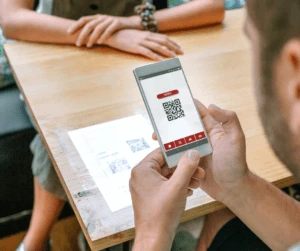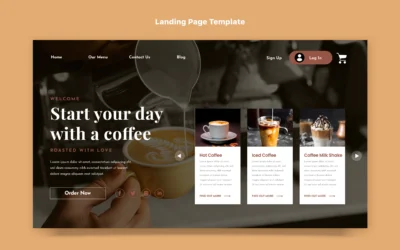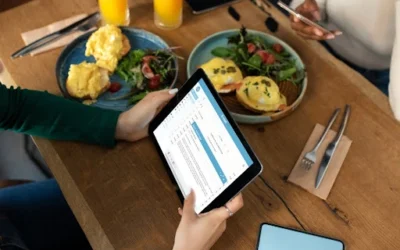Certain things will always remain the same.
Excellent food, a welcoming atmosphere, and exceptional service will always attract customers back for more. However, restaurant operators have many concerns beyond this.
Besides providing outstanding experiences, they must handle tasks ranging from managing staff to controlling operational expenses. Managing such establishments is intricate.
This is where technology plays a crucial role – offering modern solutions to drive success in restaurants. Customers now anticipate seamless interactions and a range of new technologies assist operators in meeting these expectations.
Restaurant software is now a necessity, not just an option. It has become essential for conducting business and staying competitive. Restaurant proprietors and operators should consider questions such as:
– How can software help you stay ahead?
– What solutions should be part of your technology arsenal?
Why is investing in restaurant software worthwhile?
Adopting new restaurant software and technology not only simplifies your work but also significantly impacts your profitability. Here are a few ways in which restaurant software can help you progress:
Operate More Efficiently
The National Restaurant Association says that if restaurants use technologies like POS (Point-of-Sale) systems and KDS (Kitchen Display Systems), they can increase their efficiency by as much as 20%. During peak hours, these efficiency improvements enable you to serve more customers and keep them satisfied.
Reduce Errors
As the saying goes, “…to err is human.”
Human errors are inevitable. What matters is how businesses minimize the occurrence and mitigate the impact of mistakes that are likely to happen.
Restaurants that fail to address these issues face repercussions such as negative reviews, dissatisfied customers, and damage to their reputation. Adopting specific technologies can enhance error-prone activities like ensuring order accuracy, enhancing inventory management, and more.
Improve the Experience for Guests and Customers On-Site
Whether it involves seamless reservations with AI customer service or smooth ordering and payment processing software, customers now expect to interact with technology more frequently. A Deloitte survey revealed that 70% of diners believe that technology enhances their dining experience.
Integrating technology is an excellent way to meet and surpass customer expectations.
Minimizing Waste and Managing Costs
Costs are a constant concern for restaurant operators. Reducing expenses is a significant priority, especially with increasing inflation, staffing challenges, and food wastage. For example, the National Restaurant Association found that using technology to manage inventory can reduce food costs by 2-5%. This can lead to significant savings over time, which restaurant owners can use to reinvest in their business.
Make Informed Decisions
One of the key advantages of using restaurant software is the wealth of data it provides. It offers valuable insights into customer preferences, popular menu items, peak business hours, and more.
Software enables businesses to make informed decisions to better respond to changing trends and customer preferences.
Best software every restaurant needs
There’s always room to improve. Which problems are causing the most trouble, and how do you plan to solve them?
Every restaurant is unique and has its own challenges. Software can help overcome these challenges and improve the business.
But it’s important to choose the right software.
For a good return on investment, restaurants should use various tech tools that can save time, impress customers, and help the business grow.
Here are the top 13 must-have restaurant software platforms.
1. Point-Of-Sale
A strong POS (Point-of-Sale) system is the foundation of today’s restaurant business. It simplifies transactions, tracks sales, and manages orders seamlessly.
SmartPOS is an excellent example. It processes payments and provides valuable insights into sales patterns and customer behavior.
2. Payment Processing Platforms
Making payment processes easier can improve customer happiness and make operations more efficient. Payment processing tools like SmartPOS offer secure, quick, and contactless payment options. These systems cater to different customer needs and make transactions quick and safe.
3. Online Ordering Tools
In the age of convenience, online ordering platforms have become indispensable for restaurants. Services like DoorDash, UberEats, and Grubhub allow customers to place orders from home or on the go. Using these platforms can broaden a restaurant’s visibility and potentially boost sales.
4. Kitchen Display Systems
Efficiency in the kitchen is crucial for timely order fulfillment. A Kitchen Display System (KDS) takes the place of old-fashioned paper tickets, making sure that chefs get orders without delay. This minimizes errors, enhances communication between the kitchen and front-of-house staff, and ultimately leads to quicker and more accurate service.
5. Inventory Management Solutions
Managing inventory is not easy, but it’s essential for cost control and preventing waste. Inventory management tools to automatically keep track of stock levels. This helps restaurants make their supply chain operations smoother, lower food costs, and reduce risks related to inventory.
6. Reservation Management Software
For fine-dining establishments or full-service restaurants, a reservation management solution is indispensable. Apps like SmartWAIT enable customers to book tables online. While a seamless experience for guests, it also allows restaurants to optimize seating arrangements and staff schedules.
7. Software Powered With Artificial Intelligence (AI)
AI for restaurants is becoming more common as interest in artificial intelligence has exploded over the last few years. It’s integrated into a lot of the software mentioned previously like POS or phone systems. AI improves operations and helps create enhanced experiences for all visitors.
8. Phone Systems
In the restaurant industry, managing phone calls can be a challenge for front-of-house staff, often causing distractions from on-site guests and frustrations during busy service hours.
Companies like Slang.ai offer customizable AI phone answering solutions that operate around the clock. These systems handle tasks such as answering customer inquiries and updating reservations, freeing up busy staff members.
Customers appreciate personalized phone interactions, while restaurant staff save time and effort by avoiding the constant interruptions of ringing phones.
9. Contactless Ordering And Payment
In the current landscape post-pandemic, contactless solutions have become increasingly common.
Systems like Milagro facilitate contactless ordering and payment, allowing customers to browse menus, place orders, and settle bills using their smartphones. Restaurants can implement QR code-based ordering systems to reduce physical contact and streamline the ordering process.
10. Customer Relationship Management (CRM) Software
Establishing and nurturing strong customer relationships is vital for a restaurant’s success. CRM software aids in effective customer data management, preference tracking, and personalized interactions.
For instance, Milagro is tailored for restaurants that offer CRM functionalities. With CRM tools, restaurants can send targeted promotions, loyalty rewards, and personalized offers, fostering customer loyalty.
11. Staff Scheduling and Management Tools
Managing restaurant staff involves handling shifts, tracking hours, and ensuring labor law compliance. Staff scheduling and management tools simplify these tasks by aiding in schedule creation, cost tracking, and staff performance management. These tools enhance productivity and satisfaction among the workforce, with some utilizing analytics to schedule staff efficiently during peak hours.
12. Digital Loyalty App
Customers appreciate receiving rewards, and while traditional paper loyalty cards work, they can get lost easily. A digital loyalty app provides a safer and more practical solution with enhanced tracking capabilities. By tracking orders, restaurants can anticipate which meals to offer as rewards, identify popular dishes, and adjust menus to boost sales based on customer preferences. For instance, if customers love desserts, adding more options can increase sales.
13. Restaurant Customer Data Platform Tools
As the restaurant industry shifts online, data providers are offering robust platforms filled with customer insights to meet market demands. Companies use these platforms to understand markets, prospect for sales, and leverage third-party data to enhance operations and marketing strategies. Understanding target markets and specific data fields within the food service industry is crucial. Tools like Milagro enable deeper data analysis, providing detailed menu insights, customer trends, and sales data for improved decision-making and profitability. Restaurant technology providers aim to offer comprehensive menu data and market insights to drive sales and stay updated with industry trends.
Here are some examples of restaurants that have embraced new technology today
– McDonald’s: This invested in self-order kiosks and mobile ordering, leading to increased sales and customer satisfaction.
– Domino’s Pizza: Implemented GPS tracking for deliveries and a user-friendly mobile app, resulting in improved sales and streamlined processes.
– Subway: Adopted mobile ordering and delivery partnerships to enhance customer experience and compete effectively in the fast-food market.
– Starbucks: Introduced mobile ordering and payment options to enhance customer convenience and reduce wait times, resulting in higher sales and customer satisfaction.
– Sweetgreen: Utilized automation and data analytics for operational improvements and personalized customer experiences.
Check out these three affordable technologies that can boost profits for restaurants:
- Digital Menu Boards: Digital menu boards are a cost-effective way to showcase menu items, promotions, and pricing in a visually appealing and dynamic manner. By updating menu items and prices easily, restaurants can promote high-margin items, specials, and combos to boost sales and profitability.
- Online Ordering System: Implementing an online ordering system allows customers to place orders conveniently from their devices. This technology can help restaurants reach a wider audience, increase order accuracy, reduce wait times, and encourage repeat business, ultimately leading to higher profits.
- Inventory Management Software: Utilizing inventory management software can help restaurants track ingredient usage, reduce waste, and optimize purchasing decisions. By efficiently managing inventory levels and reducing food costs, restaurants can improve their bottom line and increase profitability without significant upfront costs.
Technology can increase restaurant sales by streamlining operations, enhancing customer experiences, and maximizing profitability. By implementing IT solutions for both the front and back of the house, restaurant operators can leverage digital transformation to drive growth. For example, Crazy Bowls and Wraps experienced a 38% increase in average ticket size by embracing technology, highlighting the tangible benefits of integrating technology in Quick Service Restaurants (QSR).
By automating and streamlining processes using various technology solutions, operators can strike a balance between fostering customer loyalty and optimizing profit margins. These solutions can include digital menu boards, online ordering systems, inventory management software, and customer data platforms, among others. By embracing technology, restaurants can improve efficiency, increase sales, and create more personalized and seamless experiences for their customers, ultimately leading to higher revenue and profitability.
In 2024, several trends are expected to shape the restaurant industry, with early adopters leading the way in embracing these changes. Some key trends anticipated include:
- Sustainability Initiatives: Restaurants are increasingly focusing on sustainability, including reducing food waste, sourcing local ingredients, and implementing eco-friendly practices. Early adopters are likely to invest in sustainable packaging, energy-efficient equipment, and environmentally conscious practices to attract environmentally conscious consumers.
- Technology Integration: The integration of technology in all aspects of restaurant operations is set to continue evolving. Early adopters may explore AI-driven customer service, robotics in the kitchen, and advanced data analytics to enhance efficiency, improve customer experiences, and drive profitability.
- Personalization and Customization: Consumers are seeking more personalized dining experiences, leading to a rise in customization options and tailored menus. Early adopters may leverage customer data platforms, loyalty programs, and menu personalization tools to cater to individual preferences and create unique dining experiences.
- Ghost Kitchens and Virtual Brands: The concept of ghost kitchens and virtual brands is gaining traction, allowing restaurants to operate delivery-only concepts with lower overhead costs. Early adopters may experiment with virtual brands, partnerships with third-party delivery platforms, and optimized delivery logistics to tap into this growing trend.
- Health and Wellness Focus: With an increasing emphasis on health and wellness, restaurants are expected to offer more nutritious options, allergen-friendly menus, and transparency in ingredient sourcing. Early adopters may prioritize menu innovation, nutritional information disclosure, and partnerships with health-focused brands to cater to health-conscious consumers.
Early adopters who proactively embrace these trends and innovations are likely to stay ahead of the competition, attract new customers, and drive growth in the evolving restaurant landscape of 2024.
What are the advantages of using new technology in the restaurant business?
Integrating new technology in the restaurant sector can bring numerous advantages for businesses. Here are some of the key benefits:
- Enhanced Efficiency: Technology can automate time-consuming tasks like order processing and inventory management, allowing staff to focus on other responsibilities. This can result in quicker service, shorter wait times, and increased customer satisfaction.
- Cost Efficiency: Technology can lower labor costs by automating tasks and reducing the need for additional staff. Additionally, it can help minimize food wastage through precise inventory tracking and ordering, leading to savings on food expenses.
- Improved Customer Experience: Technology can offer customers a more personalized and seamless experience, for instance, through mobile ordering or personalized recommendations based on previous orders.
- Revenue Growth: Technology can boost revenue by attracting more customers, increasing order values, and reducing order inaccuracies.
- Competitive Edge: Embracing new technology can help restaurants stay ahead of the competition and differentiate themselves from rivals who have not yet adopted similar technologies.
- Enhanced Data Management: Technology can provide valuable insights, such as customer demographics and popular menu items, enabling businesses to make data-driven decisions to enhance operations and menu offerings.
Conclusion
The restaurant industry is evolving through technological advancements like AI, automation, digital ordering, personalized experiences, and food delivery tech. These innovations streamline operations, enhance safety and convenience in transactions, boost customer retention, and extend restaurant outreach. Additionally, air purification tech is ensuring a safer and healthier environment for customers and staff. Future developments in restaurant technology are anticipated to further elevate customer dining experiences and operational efficiency.





